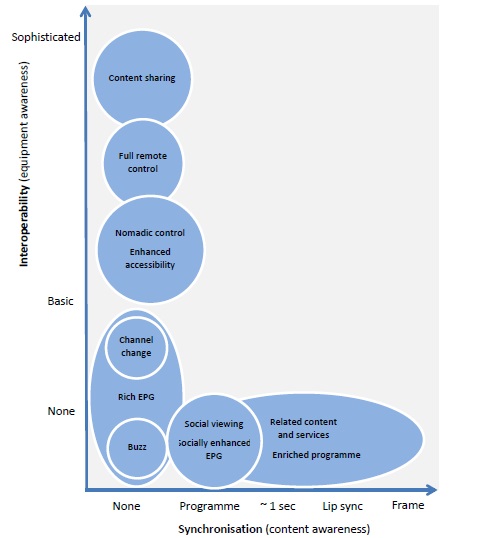All second screen apps come with their own set of functionalities. At the same time, there are mobile applications that may combine a certain set of functionalities but differ by other types of function. A report by Technologia conducted for Ofcom (the communications regulator in the UK) has put together a classification of second screen apps based on the nature of their functionalities. We are reproducing the list here, along with including some key facts for each app type that may benefit broadcasters and advertisers.
The report took thirty-eight widely used mobile applications and analyzed each app’s component functionalities. Based on the discovering, it found applications could be divided by three groups of components. These are (1) control and access, (2) search and discovery and (3) contextual enhancement, each including a number of key functions as follow:
Control and access: channel change, full remote control, nomadic control, content sharing and enhanced accessibility.
Search and discovery: rich electronic program guide (EPG) and socially enhanced EPG.
Contextual enhancement: social viewing, programme enrichment and related content and services.
The report also found that some applications could provide more or less functionality than what is usually typical in a group component. Thus, second screen apps that can be included in either one of the following categories could offer different function combinations even if they are part of the same category. Based on the report, there are ten types of second screen apps.
(M) Consumer Electronics (CE) manufacturer produced remote control apps
(P) Platform-produced apps to provide access to EPG (rich, socially enhanced, or regular schedule) and control the set-top box or connected TV box or service (Apple, YouTube etc.)
(B) Broadcaster produced apps to enrich viewer experience of TV content
(3RD) Third party produced apps to provide access to contextually enhanced experience (social activity, betting, shopping)
(R-EPG)Third party produced apps to provide access to rich EPG, both with and without capacity to change channel
(S-EPG) Third party produced apps to provide access to socially enhanced EPGs, both with and without capacity to change channel
(COMP) Apps with comprehensive features including rich EPG, social EPG and programme-related information and services
(APPR) Apps that have been appropriated to second screen, mainly in the field of social activity around TV content
(A) Accessibility related functions, either via native capabilities of smart devices (e.g. iOS’s VoiceOver) or as third party apps
(MISC) Miscellaneous
Taking into consideration the growing number of smartphones and tablets, subsequently use of mobile applications and growth of second screen apps, the report estimated that certain types of mobile apps could show more network effects than others. To understand what a network effect is, we can look at Facebook. The social network thrives on its number of users. The more users there are, the bigger the network effect. A network effect is thus when a product becomes more valuable in the eyes of a customer when more people use it.
The report indicated that:
M type of apps is unlikely to have possible network effects.
P type of apps is also unlikely to have possible network effects.
B type of apps apps could have possible network effects from audience participation in games and contests.
3RD type of apps could exhibit possible network effects.
R-EPG type of apps is unlikely to have possible network effects.
S-EPG type of apps could have generic social media network effects and network effects from app-specific social media.
APPR could also have generic social media network effects and network effects from app-specific social media.
It is important to note, according to the study, that the impact of second screen apps, though being very high, depends largely “on the development of appropriate second screen applications.” In this respect, the study found that:
P, M, R-EPG and S-EPG types are applications that could be used when not attending to the TV, whereas APPR, B and 3RD are specifically meant for use with first screen content or television viewing. The report also provided a frame of work (pictured below), based on synchronization and interoperability and on the three groups of components identified earlier, that could assist broadcasters in developing second screen applications more to their advantage.

Source: Technologia